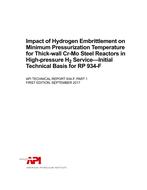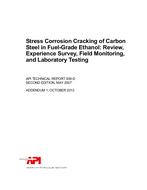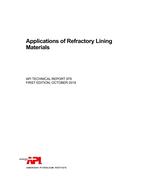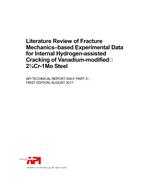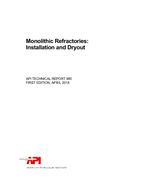API TR 934-F Part 1 – Impact of Hydrogen Embrittlement on Minimum Pressurization Temperature for Thick-wall Cr-Mo Steel Reactors in High-pressure H2 Services – Initial Technical Basis for RP 934-F, First Edition
The objective of this study, in support of API Recommended Practice 934-F (Guidance for Establishing a Minimum Pressurization Temperature (MPT) for Heavy Wall Reactors in High-temperature Hydrogen Service During Startups and Shutdowns), is to establish the technical basis for determining a minimum pressurization temperature necessary to avoid Internal Hydrogen-assisted Cracking (IHAC) of weld metal and base plate of temper-embrittled 2¼Cr-1Mo steel in high-pressure H2 service. The threshold condition for the onset of subcritical crack propagation, and its dependencies on dissolved hydrogen concentration, temperature, and steel purity/temper embrittlement, are targeted as particularly important to pressure vessel safe operations.
A second objective is to improve the underlying database for fracture mechanics fitness-for-service modeling of IHAC. Both analyses are built on the conservative rising-displacement threshold stress intensity factor for IHAC (KIH).This investigation has accomplished five tasks, leading to conclusions that are sufficient to establish RP 934-F on MPT to conservatively avoid IHAC in 2¼Cr-1Mo steel.
Task 1—Summarize and clarify the technical approach, assumptions, data, and modeling results used in Phase II JIP research to quantitatively establish the H concentration and temperature dependencies of the threshold stress intensity, KIH, for IHAC and the concentration dependence of MPT for moderate-impurity 2¼Cr-1Mo steel.
Task 2—Validate the Phase II correlation of KIH and critical temperature vs H concentration, based on new analyses of post-Phase-II IHAC data.
Task 3—Enhance the Phase II analysis of KIH vs crack tip H concentration, and thus MPT, by describing the interaction between temper embrittlement and IHAC using JIP Phase I data so as to predict the influence of modern steel purity.
Task 4—Build on the hydrogen-damage-mechanism-based master correlation between KIH and crack tip stress field/microstructure-trapped H to develop an H concentration similitude parameter that is useful in engineering analysis of thick-wall reactor FFS and MPT.
Task 5—Validate the empirically based trends and predictions of the effects of temperature and steel purity on the threshold stress intensity through consideration of state-of-the-art theory and micromechanical modeling of IHAC.
Product Details
- Edition:
- 1st
- Published:
- 09/01/2017
- Number of Pages:
- 118
- File Size:
- 1 file , 3.3 MB
- Product Code(s):
- C934F101, C934F101, C934F101
- Note:
- This product is unavailable in Russia, Cuba, Syria, North Korea, Ukraine, Belarus, Iran

